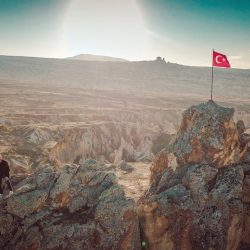“When planning for a year, plant corn. When planning for a decade, plant trees. When planning for life, train and educate people.”
Chinese proverb: Guanzi (c. 645 BC)
Modern society has already made the leap from an industrial age to an age of information, thus rapidly increasing the amount of knowledge, complexity and challenges. Modern people face two options: either to acquire new skills and abilities and adapt themselves to the new world of endless opportunities, or to observe with passive resignation the demands of the modern working world, unable to carry out their duties appropriately.
The constantly changing and evolving world poses new laws that lead to the introduction of new policies. New ideas and methods emerge. New problems demand new solutions. The ability to grasp new concepts, make new choices, and go on learning and adapting throughout life has become crucial. Education is no longer something that happens when people are young; it has become a lifelong process.
People’s ability will no longer be judged merely by qualifications obtained in the past, but will also be evaluated by their capacity to learn and adapt in the future. Those who cannot adjust to the new rules will surely confront unemployment, poverty and despair as the old jobs disappear and the old systems crumble.
Learning is not just important to make sure that people keep acquainted with the developments in a particular field. It is also an important source of motivation, stimulation and job satisfaction. It is the key to achieving our full potential since human beings possess the ability to learn throughout their lives.
We do have the capability to change our lives through learning at any age and knowledge does have the power to transform the world. It is easy to retire from the demanding everyday into some isolated and private paradise where we can only reflect on the questions of the time. A better choice is to embrace the ever-changing reality with both wisdom and action, because the world is unfinished and it is our responsibility to keep building and creating. Lifelong learning is, thus, essential because it helps us to keep in tune with trends and developments in the world. Lifelong learning is a feature of modern life and will continue to be so.
The education of the nation is too important a matter to be left to politicians, especially to the types of politicians that existed in Serbia. We do not have any more time. We are running a very significant race. The reform has to be immediate and more rapid since our goal is to compare with Europe. In order for this to be possible, Serbia must have adequate profiles of educated people.
Nowadays, an outstanding result requires interdisciplinary education. One needs to possess a great knowledge of many disciplines to get results. For example, a doctor has to be acquainted with microbiology, quantum mechanics and bioelectronics in order to be successful in genetics.
There can be no development in computer science or development of new software without mathematics and physics. There is no success in economics and finances if there is no solid mathematical background. Taking everything into account, Serbia needs Europe to receive its knowledge and financial help in order to improve its state.
Serbia has to recognize, strengthen and associate its scientific, technological and educational institutions with European ones. Serbia needs educated and highly-qualified people in order to execute its reforms. It requires not only better internal assessment and external review, but also international participation, cooperation and networking. Needless to say, Serbia requires lifelong learning methods in order to become what it deserves – an integral part of contemporary civilization and the international community.
Serbia : A Brief Historical Background
The Republic of Serbia is a picturesque country in Central and Southeast Europe with a population of about 8.1 million people (2003). It is bordered by Romania and Bulgaria in the east, Albania and the Republic of Macedonia in the south, Montenegro , Croatia and Bosnia and Herzegovina in the west, and Hungary in the north. The capital of Serbia is Belgrade , the largest city in Serbia , which lies at the confluence of the Sava and Danube rivers.
Serbia , due to its attractive strategic location, was subjected to invasions by many peoples. It is believed that Belgrade was razed to the ground by thirty different armies. Serbia has continually been going though many periods of hardship and economic difficulty. One of the most astounding facts about Serbia is that it was under the Ottoman occupation for almost four centuries (between 1459 and 1804)! However, most Serbs managed to keep their culture and religion in spite of the long period of Ottoman rule.
Not that the recent past was any better. It was during the 1990’s that Serbia underwent a total degradation, due to controversial politicians, who aggravated its state to the utmost. Corruption, bribe, low standards of morality and minimal living standards were all traits of the ’90s. Throughout that period most people, and particularly intellectuals, lived like moles in the heart of the twisted world. That period of poverty, violence and aggressiveness required the deepest wisdom and spirituality, courage and struggle to resist the chaos. The international isolation Serbia suffered at that time ended in October 2000. A democratic government was elected and the people of Serbia finally got the chance to start living like humans, to begin expanding their knowledge and to start feeling the influence of Europe and the world.
Bologna Process in Serbia
Nowadays, the world has become much smaller. The world, and specially Europe , is quite aware of the existence of Serbia . Serbia has, together with Europe , the same wish: to become part of it and to be complementary. Speaking in terms of reforms, Serbia should continue standardizing many rules with Europe , but above all, the Bologna Process in high education.
Serbia offers higher education at six state universities and six accredited private universities. Most students attend state universities, but the state does not provide funds for all of them. At private universities students exclusively pay for their schooling.
High education institutions in Serbia have started reforming the high education system since 2000. Serbia signed the Bologna Declaration in September, 2003. However, it was not until September 2005 that the high education law was enacted and conditions were provided for introducing important structural changes in accordance with the Bologna process.
Although the changes in the high education system can be felt today, it is only the beginning, practically speaking. The system requires flexibility and quality improvement.
Serbia has started executing the plan of the Bologna Declaration. The Mission statement , concerning the strategy of reform decided on by the Ministry of Education and Sports (first held in February, 2001) included several things – to form a modern high education system in accordance with the Bologna Process, to reduce not only the number of students who quit their studies, but also the duration of the studies. Besides, the introduction of a two-tier system with European system of credits (ECTS) was agreed on, as well as the harmonization of the high education system with the European tendencies.
Moreover, the focus was on the introduction of control mechanisms (which will guarantee a high quality education results, training and research), along with the new curriculum appropriate for the national needs and the market demand. In addition, conclusions were drawn to foster interdisciplinary programmes for new professions needed in the new technological era, and to develop a concept of applied studies which would provide skills and abilities required by the labour market. Last but not least, it was decided that students should be included as partners in the education process, besides the encouragement of students and teachers’ mobility.
Ministers responsible for higher education in 45 European countries met for a mid-term review in Bergen on 19-20 May 2005. The meeting was dedicated to the reforms in education systems and to setting goals and priorities towards 2010. It was focused on three priorities: the degree system, quality assurance and the recognition of degrees and periods of study. After the reports submitted by the ministers, it was estimated that Serbia should be given 2.2 points (out of maximum 5). It was rated very low, with only Bosnia and Herzegovina (2.1) and Andorra (2 points) following it.
However, Serbia was given mark 4 (the maximum mark was 5) at the meeting dedicated to high education reforms, held in London (October, 2007). Now, Serbia is among the first ten countries in Europe , in front of Sweden (3.66), Ukraine (3.83), Cyprus (3.83), Greece (3.75), Russia (3.66), Spain (3.5), etc. The best marks were given to Norway , Scotland and Denmark (4.83). Taking into account the previous results in Bergen , this has been a great success.
Nevertheless, it is quite clear that this is only the beginning. The state of Serbian universities is far from satisfactory. There are many more things yet to be done Successful implementation of the Bologna process needs considerable adjustment of the higher education legal framework. Serbian academic society waited until September 2005 to get the legal framework that was consistent with Bologna declaration principles.
The 2005 law implied harmonization with the European High Education system, promotion of students and professors’ mobility, and above all, it made it possible for the National Council for High Education to come into being. The Council is an independent body which has established the Accreditation and Quality Assurance commision, which is responsible for official approval, evaluation, assessment of the curricula and quality assurance of high education institutions.
What has been done at many high education institutions in Serbia is the introduction of restructured academic study programmes, lasting three or four years, as well as the ECTS. (Slika 4) As far as the 2007/2008 academic year is concerned, students were enrolled in high education institutions for Bachelor, Master and PhD programmes compliant with the Bologna Principles.
However, Serbia should make concrete progress in establishing Bachelor and Master degrees at every university, continue developing quality assurance systems and advance in the issue of the recognition of diplomas. It is a disappointing fact for many students to study hard in order to graduate, and still, their diplomas do not have any value in the world. Another disappointing fact is that many students buy their diplomas at private universities without making any effort.
(Slika 5) Not to mention the curricula at many universities, which are still out-of-date and obsolete. To illustrate, students at the Faculty of Economics in Ni š take many examinations which are mostly based on the theories and the political practice of Marxism. (Slika 6) Then, students of electrical or electronic engineering, the faculty of which is consedered to be one of the most demanding faculties in Serbia, finish their studies without any practical knowledge. At the end of their difficult and time-consuming studies, which usually lasts for five years, they find themselves at the very beginning, as far as the acquired applicable knowledge is concerned. Moreover, nepotism, bribe and corruption at universities is still more than evident, resulting in the discouraging and disappointing collective consciousness among the students. All this leads to a general depression of the young in Serbia who graduate without practical knowledge and find it very hard to find adequate jobs.
Unemployment is still a basic problem in Serbia. According to the facts of the Ministry of the Young and Sports* , the largest number of the unemployed among the young are women (55 %), and then come those who have not finished primary school. The great majority is not even registered on the list of the labour market and they accept almost anything just to get work: they volunteer, they work unregistered, and many of them do not even have a single day in the employment record up to their thirties.
*an article on the unemployment of the young in Serbia in the Blic (a Serbian daily newspaper, Tuesday November 13, 2007 )
In need of European Help
A great number of young people do not even apply to the Employment Bureau because they do not believe they will get a job in such a way. Every second person does not succeed in getting employed by the Bureau. Most employers have need of employees with at least three years of previous work experience and this is a serious problem for the young who have just graduated form many faculties. The graduates in Serbia are revolted at the fact that their studies do not provide them with any practice. Consequently, they volunteer even for half a year and when they finish their voluntary work they do not recieve any evidence for the experience. Conversely, voluntary work is registered in the employment record in the countries of Western Europe.
The number of the young up to 25 on the labour market is very low, about 37,4 %, while it is about 10 % higher in the European Union countries. Frequently, the reason for such statistics is the duration of studies, which takes even more than seven years. Certificates of non-formal education, that is, various courses and seminars are not accepted. In contrast, these courses are very expensive, and, undeniably, necessary for a young peron’s education and further development.
Currently, the undertaken high education reforms are not equal at all universities. Some universities have successfully and fully executed the reforms, while others have not even started. The present organization of some universities as weak legal autonomous faculties is very much inherited from the past and is proving to be very resistant to any change. Their lack of knowledge about the system, lack of vision and of basic analytical skills of the policy makers makes things even worse.
Management in High Education
As far as the management in the high education system is concerned, it should have a clear goal: to get activities completed efficiently and effectively. Management starts with planning. Good management starts with good planning.
Strategic plans should establish overall objectives; operational plans should specify details on how individual objectives are to be achieved. Strategic planning implies that an organization should define its direction of functioning and decide on giving the proper assignments to proper personnel in order to achieve its aims. Strategic planning determines exactly where an organization stands, where it wants to go and how it will get there. It is the formal consideration of an organization’s future course and it usually sets its goals for the upcoming 3-5 years. A successful strategic plan usually consists of a vision, mission, objectives and time limits, as well as the analysis of the organization’s advantages and disadvantages, and the evaluation of the results.
The difference between the definition of a mission and the definition of a vision is that the definition of the mission is focused on the current state of an organization, while the vision is focused on the future of the organization. In other words, the vision exhibits the optimistic view of the organization’s future, while the mission principally describes the purpose of the organization.
Defining the mission is a crucial element in the strategic planning of an organization. Speaking in terms of high education reforms in Serbia , it is quite clear that Serbia has already been given a clear strategic plan by the European Union. Having adopted the missions and the policy for the high education reform, the management of the universities should start directing and organizing its work on the reforms more strictly and systematically.
In terms of operational plans of high education reforms in Serbia , there is a need for clear timetables and deadlines. People must be coerced or controlled to do work to achieve the given objectives. Establishing structures for monitoring and review, learning from each other, and staff development and training are also issues that should be concentrated on.
The roles and responsibilities of individuals in quality management should be clearly defined. Then, priorities for action ought to be identified. Moreover, consistent examination procedures, criteria, and standards should be ensured, as well as effective and transparent criteria for the appointment, promotion, and reward of staff that define and apply them in all higher education institutions. National and cross-border cooperation within wider Europe should be increased, by taking as reference the objectives of the Bologna Process and developing appropriate networking activities. The need for further financial and human support provided by international organizations and various academic and donor organizations is necessary at this phase of the higher education reform processes in Serbia.
High Education Reforms in Serbia : Overview
To summarize, Serbia has started implementing the principles of the Bologna Process. The evaluation of the high education system showed that the education system has significantly moved from the starting point in the 2001-2003 period. However, the current state of universities is still unsatisfactory. Diplomas are not recognized world-wide, high level of bribe and corruption exists, university curricula are out-of-date and do not provide adequate practical knowledge for the labour market demand.
The Bologna Declaration was signed in September 2003. Nevertheless, a lot of work on the implementation of the undertaken obligations is yet to be done. The cooperation with EU universities should continue, as well as the exchange of academics and students and lining up with the current trends in the European high education system.
Trying hard to implement the principles of the Bologna process successfully and become a knowledge-based society, Serbia is still in need of European help. And Lifelong Learning is the principal medium of achieving this goal.
Bibliography
-
Abrahams, Jeffrey, (1995), The Mission Statement Book, Berkley , California : Ten Speed Press
-
Bogoeva-Sedlar, Lj., (2003), On Change: Essays 1992-2002, Niš, Prosveta
-
Dulanović Živko , Ondrej Jaško, (1995), “Projektovanje organizacione strukture”, FON, Begrad
-
Longman Dictionary of Contemporary English, (2000) Oxford University Press
-
Oxford Thesaurus of English, (2005), Oxford University Press
-
Encarta Encyclopedia Deluxe 2006, Microsoft Corporation, Redmond
-
Evans , Virginia , (2004), Successful Writing Proficiency, Express Publishing
-
http:// www.see-educoop.net
-
http:// www.dpu.dk
-
http:// www.12manage.com
-
http:// www.bologna-bergen2005.no
















Add Comment